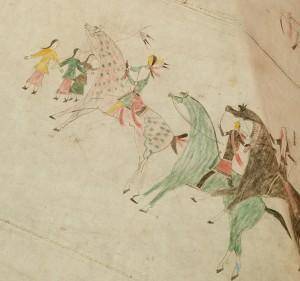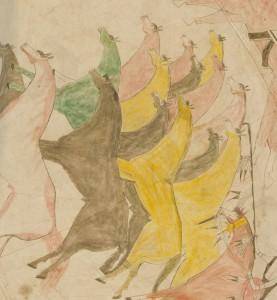After learning about the artistry and cultural importance of the Lakota Tipi, students will use their imaginations and creativity to make tipis that tell stories about their own lives.
Students will be able to:
- list at least two characteristics of the Tipi;
- describe at least three functions of the Tipi;
- write down their answers to “What if…” questions that involve higher order thinking; and
- build, design, decorate, and discuss tipis of their own.
Lesson
Day 1
- Warm-up: Have students write down everything they can think of in their rooms. Encourage them to be detailed and include how many of each thing (e.g. books, hair ties, pictures), as opposed to just general categories.
- Lead a large-group discussion on the following questions before showing students the Tipi:
- If you moved a lot, every day, every week, or even every month, would the type of home you live in now, and all of the stuff you own, make sense? Why or why not?
- What type of home and possessions would make sense? What type of home would you build?
- Would owning and taking books make sense if you had to move frequently?
- How would you remember everything that happens in your life and everything that happened to all the people in your family before you were born (assuming you don’t have the technology you have today to record everything)?
- Show students the picture of the Tipi. Using the About the Art section, talk about its history and purpose.
- To help the students better understand the importance of the Tipi, ask the following “What if…” questions; have the students write down their answers on a sheet of paper or in their journals:
- What if the Tipi wasn’t decorated?
- What if the Tipi couldn’t be moved?
- What if there was no wood to make the supports?
- What if there were no horses at the time? What might be painted on the Tipi instead? Why would horses be such an important image to show?
- Explore the images on the Tipi. Have students describe in detail what they see, perhaps making a chart or graph (if you are working on those skills in class). Talk about the story and history the images relate.
Day 2
- Students will make their own tipis using the following steps:
- write a quick draft of a story from their own lives
- sketch out images that tell the story
- use the sticks and string to build their own sub-structure (refer to the pictures of the Tipi for help)
- measure out the butcher paper to cover the sub-structure; cut to fit and then remove
- color the images from their stories onto the butcher paper, keeping in mind the 3-dimensional aspect of the tipi
- affix the outside cover of the tipi with string.
Note: You may want to simplify this process for lower grade levels. Consider having the tipi structure already assembled and the paper already cut for younger students.
- Host gallery showings with half of the class touring the gallery and the other half talking about their tipis. Switch roles and repeat.
Materials
- Paper or journals for each student to write down thoughts
- 5–10 sticks about 12–15 inches in length (from outdoors or purchased) for students to make their own tipis
- One 7–9 inch length of string for each student
- Strips of butcher paper for each student to decorate and then cover their stick structure
- Scissors
- Assorted colored markers or pencils
- About the Art section on the Lakota Tipi
- One color copy of the Tipi for every four students, or the ability to project the image onto a wall or screen
Standards
- Visual Arts
- Invent and Discover to Create
- Observe and Learn to Comprehend
- Relate and Connect to Transfer
- Envision and Critique to Reflect
- Language Arts
- Oral Expression and Listening
- Research and Reasoning
- Writing and Composition
- Reading for All Purposes
- Collaboration
- Critical Thinking & Reasoning
- Information Literacy
- Invention
- Self-Direction
Tipi
- Attributed to
- Standing Bear, 1859-1934
This tipi was made by a Lakota artist. The Lakota people lived on the Great Plains, an area roughly between the Rocky Mountains and the Missouri River, from Texas up to southern Canada. Many, but not all, of the tribes who lived on the Great Plains used tipis as their primary form of residence. In most tribes, women were generally both the makers and the owners of the tipis, although men sometimes provided assistance in their construction. They were often made from the skins of buffalo that the men hunted. Women tanned the skins and then sewed them into a pattern to create a semi-circular one-piece covering. The name “Standing Bear” is written on the Denver Art Museum’s tipi, but we are not sure whether this is the name of the artist or possibly the identity of one of the figures depicted. It was not a Lakota custom for artists to sign tipis.
The tribes who lived on the Great Plains moved frequently as they hunted for food and required homes that could be erected quickly and transported easily. The earliest tipis were relatively small but increased in size after Europeans introduced horses to the area, which allowed tribes to carry larger and heavier loads. The materials used to construct tipis were dictated by what was readily available. The tipi covering, for example, was originally made from buffalo hide. The decimation of buffalo herds in the mid- to late-1800s, along with the availability of trade goods, caused a shift to tipis made of canvas. Later, with the building of western-style housing on reservations, tipis as a primary dwelling completely disappeared.
The construction of tipis varied slightly among the different tribes. Generally, three or four foundation poles are tied together near the top while they are lying on the ground. The tripod is then lifted upright and the poles are spread at the base. Additional poles are added to create an oval floor plan. The cover is then attached to the top of a pole and spread across the frame. The two edges of the cover overlap and are secured with wooden pegs. Smoke flaps are controlled by the use of two longer poles. During the hot summer weather, the sides could be rolled up to allow air to flow in and out of the tipi. Extra warmth was gained in the winters by banking snow outside the tipi. An inner layer was also added to the tipi and grass was used as insulation between the two layers. The Denver Art Museum tipi may have been used as a decorative outer cover for another smaller cover, since it lacks evidence of smoke at the top.
The images painted onto the tipi cover probably represent battle scenes. The establishment of reservations ended the nomadic and warrior lifestyle of the Lakota. Military exploits of earlier years became more significant for the Lakota and artists kept the stories alive through their drawings. Enemy tribes, such as the Crow and the Pawnee, are painted in great detail, allowing the viewer to recognize them by their distinctive clothing and hairstyles. Tipis like this one now serve as a historical record of the lives of those who created it.
Details

Canvas
This tipi is made of canvas, with wooden poles for support. Canvas was more readily available than the traditional buffalo hide (buffalo were becoming increasingly rare) and it made the tipi much lighter and easier to transport.

Narrative Painting
This style of painting, referred to as narrative painting, depicts a military scene. Military paintings were done exclusively by men, while women painted abstract patterns. By the late 1800s, Lakota drawings began taking on more realistic proportions. Paintings were not typically painted in chronological order. Images were arranged according to the artist’s preference, recording the essence of an event and not the specifics of time or place.

Horses
Red, green, and yellow horses circle the tipi. Artists often painted horses in a more decorative manner, in colors not normally attributed to the animal. In Lakota society, horses were an important symbol of power and wealth. Artists frequently depicted them as trophies secured in battle or as the prized possession of a rider.

Enemy Tribes
Warriors from the Pawnee and Crow tribes are recognized by their distinctive hairstyles and clothing. The Pawnee warrior is shown wearing high fashioned black moccasins.
Funding for object education resources provided by a grant from the Morgridge Family Foundation. Additional funding provided by the William Randolph Hearst Endowment for Education Programs, and Xcel Energy Foundation. We thank our colleagues at the University of Denver Morgridge College of Education.
The images on this page are intended for classroom use only and may not be reproduced for other reasons without the permission of the Denver Art Museum. This object may not currently be on display at the museum.







